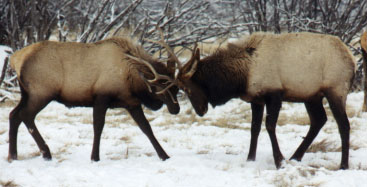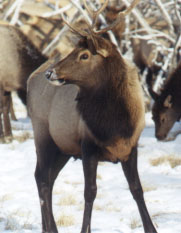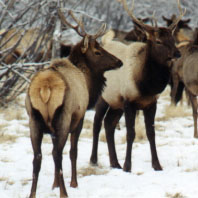 | |
|
 in locating some of the straying animals.
It's a warm summer day in late June, and research scientist Rick Rosatte is in the air over eastern Ontario searching for missing members of his adopted "family" - 70 head of elk released last January near Bancroft.
One of about 25 Ministry of Natural Resources employees with offices and labs at Trent, Rosatte is also a conjunct professor in the watershed ecosystems graduate program at Trent, and supervises two M.Sc. students on the elk program. Ontario elk stocks, originally here thousands of years ago, were wiped out through over harvesting and loss of habitat. There have been several attempts to restore elk to the province, the most recent being in the 1930s and 40s. However, most of these animals were slaughtered when it was feared they were transmitting a parasite to cattle herds. Two small herds, totaling about 60, managed to survive in the Burwash/French River area, so that is where the restocking operation began. The plan for the restoration of elk herds involves 12 partner groups and has identified six broad geographic areas offering suitable elk habitat. Almost 150 of the animals have been introduced into the Sudbury area in the last three years, and they have been making their way as far afield as Sault Ste. Marie, Parry Sound and Manitoulin Island. Other sites include Bancroft/North Hastings and the area around Kenora, where about 60 were introduced in January. All the elk being imported under the five-year plan are raised in Alberta's Elk Island National Park. A Trent student, Debbie Jenkins, will begin this fall, looking into the inter-relation between elk and deer herds. Trucked to Ontario, the elk are kept for a few days or as long as six weeks in special holding areas before being released into the wild. At least that's the plan. The animals brought to Bancroft earlier this year bolted over and through the fence and into the wild.
The animals have some adapting to do when they come to Ontario. Because they have been born and raised in a 200 kilometre national park, they aren't familiar with predators. Wolves have been the most serious problem in the Sudbury area, claiming 11 of the animals this year alone. There has also been one confirmed poaching in the Sudbury area earlier this year. Ideally a herd should grow at a rate of about 10-20 per cent annually. Results haven't been that strong yet. About 270 have been brought in and the herd now numbers an estimated 300. The animals are all tested for tuberculosis and brucellosis before being brought to Ontario. Before beginning the 48-hour trip, they are quarantined for a few days, treated with drugs to help them fight any disease and fed a special high-energy formula. |
 Earlier in the week, he received word at his Trent University office that field workers were unable to locate several members of the herd, brought in from Alberta in an attempt to reintroduce the stately animal to Ontario. It would take a couple of more trips to find the animals, which had headed south and apparently have settled near the town of Tweed.
Earlier in the week, he received word at his Trent University office that field workers were unable to locate several members of the herd, brought in from Alberta in an attempt to reintroduce the stately animal to Ontario. It would take a couple of more trips to find the animals, which had headed south and apparently have settled near the town of Tweed.
 Elk released under the program are fitted with collars so scientists can tell whether they are staying in the local area or are on the move. The collars emit a special signal if the animal dies. It's harder to keep track of calves being born in the wild, with heavy tree growth making it difficult to find them.
Elk released under the program are fitted with collars so scientists can tell whether they are staying in the local area or are on the move. The collars emit a special signal if the animal dies. It's harder to keep track of calves being born in the wild, with heavy tree growth making it difficult to find them.


